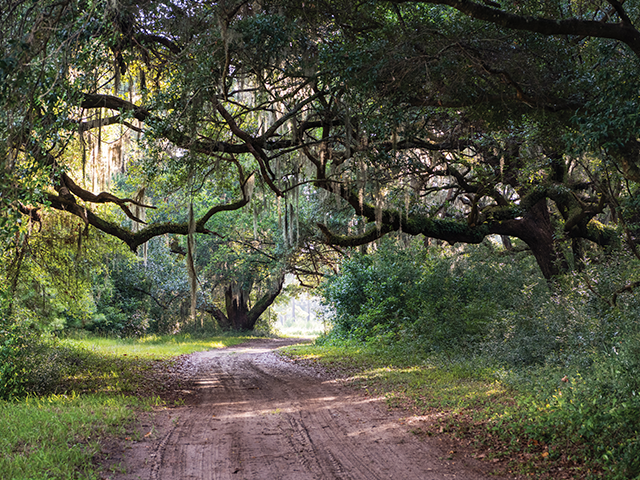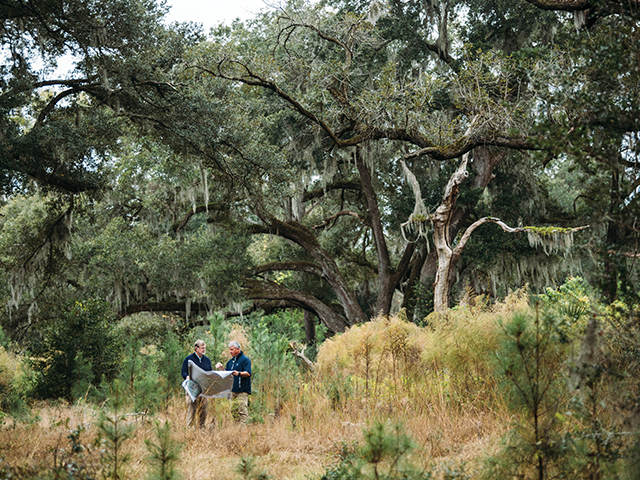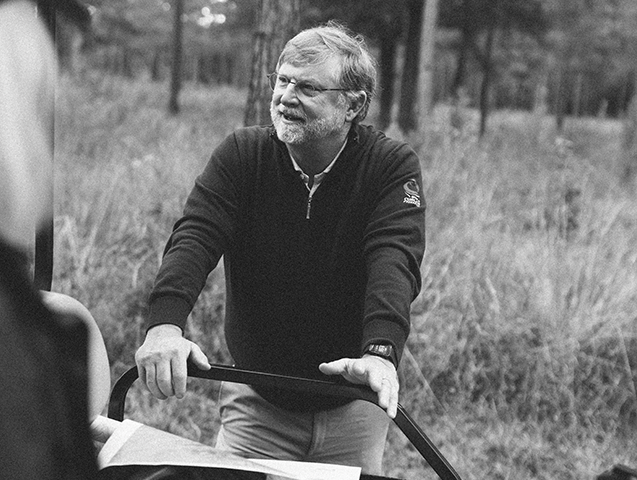Beau Welling Takes Orange Hill
Story by Sandy Lang
Photography by Joel Caldwell and Patrick O’Brien
One of the busiest golf course designers in the country spins stories and talks design under the oaks
Along this stretch of Bohicket Road, the memories begin. Beau Welling recalls his childhood visits to Kiawah Island. He zeroes in on the memory of his seventeen-year-old self and that Christmas night car accident he somehow survived.
He’ll never forget seeing a tractor’s headlight beams cutting through the night’s darkness, silhouetting the outlines of live oaks. It was a farmer from a nearby house who heard the crash and drove out to help.

Welling, who’s now a golf course designer with projects around the globe, is also a natural storyteller. “I remember the car spinning, flying through the trees,” he says, looking up into the pines on the sandy road that leads into the Kiawah Island Sporting Club.
He knows he’s lucky. Not just because of the death-defying crash that ended in a soft landing but also because of chance connections and opportunities throughout his career, like working for Tom Fazio in his twenties, founding his own successful design firm, and collaborating with Tiger Woods and TGR Design.
At fifty-four, Welling is fulfilling a dream to design a truly special project in his home state—the mixed-use development that will be built between River Road and Bohicket Road on the 933-acre Orange Hill tract, including an 18-hole golf course for Members of Kiawah Island Club.
On a late fall day, the rain stops just long enough for Welling to hop on a golf cart with Kiawah Island Club’s director of golf maintenance, Randall Glover, to lead a couple of guests on a morning tour of the property. Along the ride, the designer’s eyes follow the topography, the gentle rises and dips, and what sometimes look like remnant dunes. “Maybe they are,” he says, pondering the possibilities. “This was once the ocean.”
Welling grew up in Greenville, South Carolina, and his family had a home on Kiawah Island when he was a child. He’s known for his fervor for intellectual and creative pursuits, including earning a physics degree from Brown University (and playing on the golf team), studying landscape architecture at the Rhode Island School of Design, studying as a visiting scholar at Trinity College in Dublin (his first chance to play a links course), and earning his masters in international business at the University of South Carolina. Lately, he’s been getting to know this large Johns Island tract that has been host to the Sporting Club in recent years. Preserving the grand trees and working with the natural landscape is key to the look and feel that his firm, Beau Welling Design, will create at Orange Hill.
When completed, plans include a scenic entry off of River Road that will wind past cottages, Club buildings, and larger residences. Golf will be the centerpiece. The private golf course, along with a short course and practice facility, will encompass some three hundred acres, nearly one-third of the property’s acreage.
Welling has had a lifelong love of golf and figures he took his first swings by age two. But before the group talks more about golf and the plans for Orange Hill, the subject turns again, this time to Welling’s blue sweater embroidered with an insignia for the World Curling Federation. Yes, he nods, that’s the winter Olympic sport of curling. He beams at the question, and the conversation leads to more stories, including one about the first time he took a winter trip to Bemidji in northern Minnesota to see curling matches in person. “They couldn’t believe a guy with a Southern accent was so interested.”
His passion for the sport grew, and more than two decades later, Welling now serves as the president of the World Curling Federation. He also founded South Carolina’s first curling club in his hometown of Greenville. And while the two sports may seem unconnected, Welling contends that they have a lot in common and notes that both golf and curling were first played centuries ago in Scotland. He’s been fascinated by the sport—the sliding of stones across ice toward a target—since watching Olympic competitions in the 1990s and early 2000s.
Both golf and curling involve studying angles and trajectories, have particular terms and jargon, and are built around camaraderie, according to Welling. And, he says with a smile, each sport “offers a fine excuse to drink Scotch.”
Ah, Scotland, and those unfettered, undulating greens. A mention of old Scotland brings us back to the 933 acres stretching out before us, to spiky palmettos and sprawling live oaks, sandy pathways, and the geometry of trees.
Welling was inspired by traditional courses, and his plans for the course at Orange Hill feature “Old World slopes and contours around the greens.” From the start, he says, the course will have an aged feel because of the mature trees, especially the ancient live oaks with outstretched limbs. He’s been involved in land planning and golf course design projects around the world—from Scotland to the Bahamas to PGA Frisco in Texas—and he’s bringing that experience and vision to this project. Closer to home, he says local cues for Orange Hill include Yeamans Hall Club and the Country Club of Charleston, both impressive for their gentler imprint on the land.

Welling steps off the golf cart to unroll the conceptual master plan for Orange Hill, and he points out various features—homesites and cottages, a fishing dock by one of the ponds, wetlands and natural areas that will be conserved, and farmland plots for vegetables and flowers. About three hundred acres of Orange Hill will be dedicated to golf, including the practice area and a short course of ten 50- to 100-yard holes, along with the Club’s core 18-hole course.
The short course will be great for practice and is less intimidating for beginners, Welling explains, which is vital as interest in golf has grown in recent years, especially since the pandemic. “We want to deliver a golf experience that everyone can play, and each hole is different.”
Beyond the grand trees, numerous sandy areas that aren’t traps but simply natural to the landscape will add another aspect for interesting play. (Likely descendants of those ancient Sea Island sand dunes.) Welling suggests that the more skilled players will take on such risks and hazards differently.
Other specific features at Orange Hill will come to life once the grading and technical work begins. Welling will visit the course as it progresses and will stand again by these pines and oaks. That’s when the land planning and course design gets a finer point. Sight lines and challenges become more apparent, “and the design becomes more about what’s right in front of you.”
Almost like that long-ago night when fate sent Welling flying through the very trees where he stands now. And where Orange Hill’s new chapter will come to life. — S.L.
Learn more about Designer Beau Welling’s work and accolades:
Feature in The First Call, March 2024
Feature in Palmetto Golfer Magazine, March 2024
Feature in LINKS Magazine, January 2024
Feature in GolfDigest, May 2023
Feature in LINKS Magazine, July 2018





